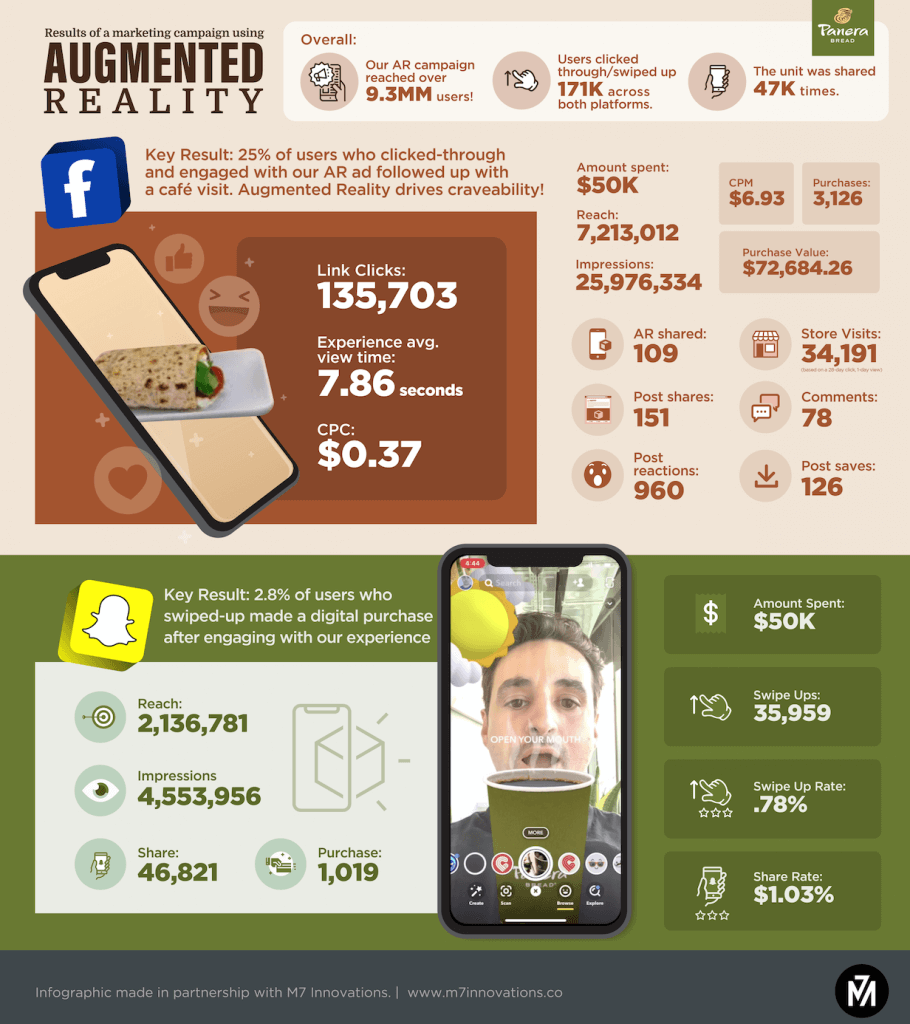
Advertising continues to be a bright spot in AR’s otherwise-challenged early days. Brand spending on AR ads is on track reach $1.98 billion this year according to ARtillery Intelligence estimates, making this one of the most high-performing subsectors of the AR universe.
This isn’t a new message, as AR traction among brand advertisers continues to be a rallying cry for industry proponents. But beyond AR ad tech providers it’s rare to get first-hand accounts from brands that have run AR campaigns. What are they doing and thinking?
To that end, we recently interviewed Panera’s director of brand marketing Kelli Nicholson for AR Insider Innovators. Along with agency partner, M7 Innovations, she broke down best practices from Panera’s AR campaigns — the focus of this week’s XR Talks (video and takeaways below).
Make it Craveable
Before getting into lessons and best practices, what were the AR campaigns themselves? Panera’s most recent AR campaign ran on Facebook and Snapchat, letting users interact with Panera’s breakfast wraps through AR lenses. This included visualizing and rotating the product.
After spending $50,000 on Facebook and Snapchat, the campaign got 9.3 million users, 171,000 clicks/swipes, and 47,000 shares. It also achieved a 25 percent store visit rate on Facebook, and a 2.8 percent conversion rate for digital purchases on Snapchat (see full stats below)
So how did Panera achieve these enviable performance indicators? There are several reasons but one glaring attribute was the quality of the 3D models that the campaign used to visualize the product. To do this, M7 worked with food-focused photogrammetry specialist Qreal.
This campaign component is especially critical with food, says M7 founder Matt Maher. Whereas some product categories don’t require high-polygon renderings to be effective, food is all about creating “craveability” and food lust, says Maher — a key lesson for food and QSR verticals.

AR Aptitude
What else did the campaign do right? Nicholson and Maher point to AR aptitude. Brands that do AR marketing as a “one-off” won’t be successful. But effectiveness can be achieved from several campaigns when brands show a commitment to the medium, and continue to learn tactics.
In addition to getting AR-smart, multiple campaigns can help brands amortize the upfront cost of AR production, such as 3D models. This squeezes more value out of sunk costs, wherein campaign ROI gets better after each one. The above was Panera’s third AR campaign with M7.
Another success factor is to optimize the calls to action that drive users to launch the AR experience in the first place. Here brands with physical locations can utilize things like signage. Consumer brands can similarly make product packaging come to life through AR markers.
Beyond the placement of calls-to-action, the messaging itself should entice users to activate the AR experience. Maher points to banner ads they ran in Bleacher Report. Animations in the ad unit showed users what to expect after they click, resulting in a 5 percent click-through rate.
Depth of Engagement
Panning back, AR has benefits beyond campaign performance and brand building, Maher points to the ability to do product research cost-effectively and at scale. In other words, brands can test-market products or menu items by tracking consumer reactions to AR renderings.
Nicholson also emphasizes AR’s benefits beyond just performance metrics. When looking at campaigns in totality, those metrics are important but depth of engagement is a bigger objective because it’s all about cultivating brand equity. This can be seen in AR dwell times.
Nicholson was also happy to beat standard benchmarks in paid components of the campaign, such as reaching 4 million impressions on Snapchat. But the real benchmark for marketers she believes is to exceed one’s prior performance. That way, she knows the brand is evolving.
Looking forward, Nicholson says it’s also important to pay attention to emerging platforms. She’s currently experimenting with TikTok, for example. Just like with AR, it’s about gaining aptitude in the native quirks of emerging platforms. And that will continue to be a moving target.
We’ll pause there and cue the full video interview below…






